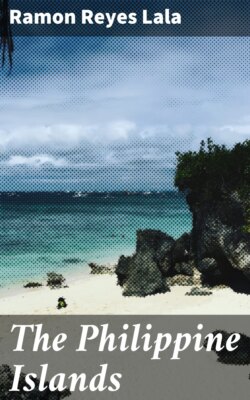Читать книгу The Philippine Islands - Ramon Reyes Lala - Страница 13
На сайте Литреса книга снята с продажи.
The Japanese, and the Martyred Saints.
ОглавлениеTable of Contents
The struggling colony was menaced by yet another foe. Early commercial relations had been entered into with the Japanese, who had established one or two trading-settlements in different parts of Luzon. It was not long, therefore, before the news of the Spanish occupation of the Philippines reached the Emperor of Japan. Accordingly, in 1593, he sent an ultimatum to the Governor-General, demanding his surrender, and that he acknowledge him as his liege lord.
The Japanese Ambassador, Farranda Kiemon, was received with great honor, and treated with all the deference due to a royal envoy: the colonists were not yet strong enough to manifest a high degree of independence when threatened by so powerful a foe. So the Governor prudently resorted to diplomacy. He replied, that, being but a vassal of the King of Spain, a most powerful and opulent sovereign, he was prevented from giving homage to any other monarch; that his first duty, naturally, was to defend the colony against invasion; that he should, however, be happy to make a Treaty of Commerce with His Majesty, and would, accordingly, send several envoys to his capital to treat concerning the same.
This done, it is related, the Spaniards were received in great state. The treaty was then adjusted to the satisfaction of both parties.
A Suburb of Old Manila.
Unfortunately, however, these envoys, returning homeward, were drowned, and shortly afterward two religious embassies were sent to Japan to renew the treaty and to convert the benighted inhabitants of that country to God and the true Church. After thirty days, sailing they arrived at their destination. The friar Pedro Bautista, chief of the embassy, was now presented to the Emperor Taycosama, and the treaty was renewed. The most important feature of this agreement was the permission to build a chapel at Meaco, near Osaka. This was opened with ceremonial pomp in 1594.
Now the chief of the Jesuits—the sect were by royal favor allowed to follow their calling among the Portuguese traders in Nagasaki—bitterly opposed what he deemed the exclusive right of his order, conceded by Pope Gregory XIII., and confirmed by Imperial decree.
The Portuguese traders, foreseeing that the arrival of Bautista and his priests was but a prelude to Spanish domination—when they, naturally, would be the sufferers—forewarned the Governor of Nagasaki.
The Emperor was alarmed; for he now also became convinced that the Philippine Ambassadors were actuated to missionary zeal by ulterior motives; and, fearing that the priests, by their doctrines, might pollute the fountain of his ancient religion—thus paving the way for their domination and his own ultimate ruin—he at once commanded that all attempts to convert the natives must cease. Bautista, in holy zeal, not heeding the Imperial injunction, was expelled, and retired to Luzon, leaving several of his embassy behind. Some of these also, obstinately persisting in violating the Imperial mandate, were arrested and imprisoned.
Upon his arrival in Manila, Bautista fitted out another expedition, and soon again landed in Japan with a company of Franciscans.
The indignant Emperor, convinced of the duplicity of the Spaniards, caused them to be seized and cast into prison. A few natives, who had forsaken the religion of their forefathers for the discord-breeding doctrines of the foreigners, were also apprehended. All—twenty-six in number—were then condemned to death. After their ears and noses had been cut off, they were exhibited in various towns, as a warning to the other foreigners and to the populace. Upon the breast of each hung a board, that announced the sentence of the wearer and the reasons for his punishment. They were then crucified, and, after lingering for several hours in great agony, were speared to death.
The colony was much perturbed when the news of the sad fate of the zealous Franciscans reached Manila. Special masses were said, and processions of monks daily paraded through the streets.
The Abandoned Acqueduct.
The Governor was finally prevailed on to send a deputation to Japan for the bodies of the executed priests; for the relics of these martyrs were fraught with too many possibilities of profit to their co-religionists to be left in a foreign country in ignominious sepulture. It is related, also, that these envoys were entertained most royally, and the Emperor gave them a long letter to the Governor, justifying with many reasons the late execution and his vigorous policy. It seems, however, that the relics were lost on the homeward voyage. Notwithstanding, many priests soon ventured to Japan, to court a martyr’s doom and to furnish relics for the adoration of their superstitious countrymen. Hence, it is not surprising that a great many other similar executions afterward took place.
Incensed at these frequent and persistent violations of his well-founded prohibition, the Emperor finally refused to treat with the embassies sent from the colony; and, as he and his successors continued to enforce their stern decrees, the transportation of Spanish priests to Japan was finally prohibited. Had the Japanese been less severe, less astute, it is highly probable that all the evil consequences that they foresaw—as a result of the Christian propaganda—would really have taken place. As it was, they saved both their religion and their Empire.
